2005 SAGES Abstracts
2005 SAGES Abstracts
2005 SAGES Abstracts
Create successful ePaper yourself
Turn your PDF publications into a flip-book with our unique Google optimized e-Paper software.
POSTER ABSTRACTS<br />
RESULTS: The mean age was 56 years (range, 28-84). Primary<br />
complaints were transanal protrusion (16), impaired fecal<br />
extrusion (13) and fecal incontinence (3). Preoperative assessment<br />
included clinical examination, selective imaging including<br />
barium enema, defecography, colonoscopy and transit<br />
studies. Twenty five pts (78%) had sigmoidectomy with dissection<br />
rectopexy, 5 pts (16%) had a left colectomy with rectopexy,<br />
and 2 pts (6%) had total abdominal colectomy and rectopexy.<br />
There were no conversions to open. Mean estimated<br />
blood loss was 205 (range, 50-800) cc. No pt needed blood<br />
transfusion. Mean number of incisions was 3.5 (range, 3-5).<br />
Mean length of largest incision was 4 (range, 3-6.1) cm. There<br />
was no mortality. Complications noted in 4 pts (12%): two<br />
developed small bowel obstruction, one requiring surgery; one<br />
instance of minor incisional bleeding and one urinary tract<br />
infection. Mean follow-up was 15.3 (4-52) months. Mean postoperative<br />
hospitalization was 4.5 (range, 2-8) days. Two (6%)<br />
pts developed full thickness recurrence: one in 10 months and<br />
another in 18 months after surgery, both of which were<br />
repaired by a Delorme procedure without recurrence. Pts with<br />
fecal extrusion impairment required a transanal mucosal excision,<br />
in 7/16 pts, all successfully treated. Twenty pts (62.5%)<br />
had complete resolution and 12 (37.5%) while improved had<br />
minor residual functional complaints.<br />
CONCLUSION: Colectomy with rectopexy for CRP or HRP can<br />
be safely performed laparoscopically with low morbidity and<br />
acceptable functional outcome. As in open surgery mucosal<br />
redundancy with fecal extrusion difficulty is a frequent sequel<br />
to anterior resection and rectopexy for HRP and transanal<br />
mucosal excision should be planned with anticipation of satisfactory<br />
results. Long term follow up studies are needed to<br />
properly assess the recurrence rates.<br />
P101–Colorectal/Intestinal Surgery<br />
SAME DAY DISCHARGE AFTER LAPAROSCOPIC COLON<br />
RESECTION, Mehran Anvari PhD, Allan Okrainec MD,Cliff<br />
Sample MD,Herawaty Sebajang MD,Ann Brannigan MD,<br />
Centre for Minimal Access Surgery, McMaster University,<br />
Hamilton, Ontario, Canada<br />
Laparoscopic colon resection has been associated with<br />
reduced length of stay. We have initiated a program of discharging<br />
patients within the same day (24 hours) after laparoscopic<br />
colon resection and with a pain pump to provide local<br />
analgesic control to the extraction excision site.<br />
5 patients with a mean age of 65.4 (range 44-83) underwent<br />
laparoscopic colon resection (3 Right Hemicolectomy for cancer,<br />
1 Anterior Resection for cancer, 1 sigmoid resection with<br />
stomal closure). The mean OR time was 131±9 mins and the<br />
median ASA Score was 3 (range 2-4). The mean time to discharge<br />
was 20.6±0.7 hours. Prior to discharge, 2 patients<br />
required oral narcotics for abdominal pain. There were no<br />
peri-operative complications and all patients were satisfied<br />
with early discharge and had unremarkable recoveries.<br />
Conclusion: Same day discharge after laparoscopic colectomy<br />
is safe and feasible in select patients with good home support.<br />
Use of a local pain pump helps reduce the need for post-operative<br />
narcotics.<br />
P102–Colorectal/Intestinal Surgery<br />
LAPAROSCOPY HAS A PLACE IN THE REVERSAL OF HART-<br />
MANN PROCEDURE, George Bouras MD, Maria Mara Arenas<br />
Sanchez, MD,Harutaka Inoue MD,Joel Leroy MD,Francesco<br />
Rubino MD,Didier Mutter PhD,Antonello Forgione MD,Jacques<br />
Marescaux MD, IRCAD/EITS, University Hospital of Strasbourg,<br />
France<br />
Background: It has been suggested that laparoscopic reversal<br />
of Hartmann procedure (LRHP) is associated with less patient<br />
morbidity and shorter hospital stay compared to open surgery.<br />
The aim of this study was to evaluate the outcomes of LRHP in<br />
order to assess whether such advantages are conveyed in our<br />
experience.<br />
Methods: A retrospective analysis of all patients who underwent<br />
reversal of Hartmann procedure between August 1998<br />
and August 2004 was performed. Data collection included preoperative<br />
(age, sex, ASA score, BMI, diagnosis, interval to<br />
reversal), intra-operative (operative time, intra-operative findings,<br />
conversion) and post-operative (morbidity, mortality, hospital<br />
stay, follow-up) data.<br />
Results: Reversal of Hartmann procedure was performed in 36<br />
patients. Twenty-two cases were performed by laparoscopy<br />
and 14 cases were performed by open surgery. There was no<br />
significant difference between laparoscopic and open groups<br />
in terms of age, sex, ASA score, BMI, diagnosis, follow-up and<br />
time to reversal. For the laparoscopic group, the male to<br />
female ratio was 13:9, mean age was 59.6 years (range 40-82),<br />
mean ASA score was 2.09 (range 2-3), mean BMI was 26.1<br />
kg/m2 (range 21.2-33.1), mean interval to reversal was 5.8<br />
months (range 1-13), and mean follow-up was 10.1 months<br />
(range 1-72). The mean BMI was lower for the laparoscopic<br />
group compared to the open group (26.1 vs 29.1 kg/m2,<br />
p=NS). Laparoscopic RHP was completed in 21/22 patients<br />
(conversion rate 4.5%), the only conversion being due to due<br />
to severe adhesions. Compared to open surgery, the mean<br />
operative time was less (174 vs 223 minutes, p
















